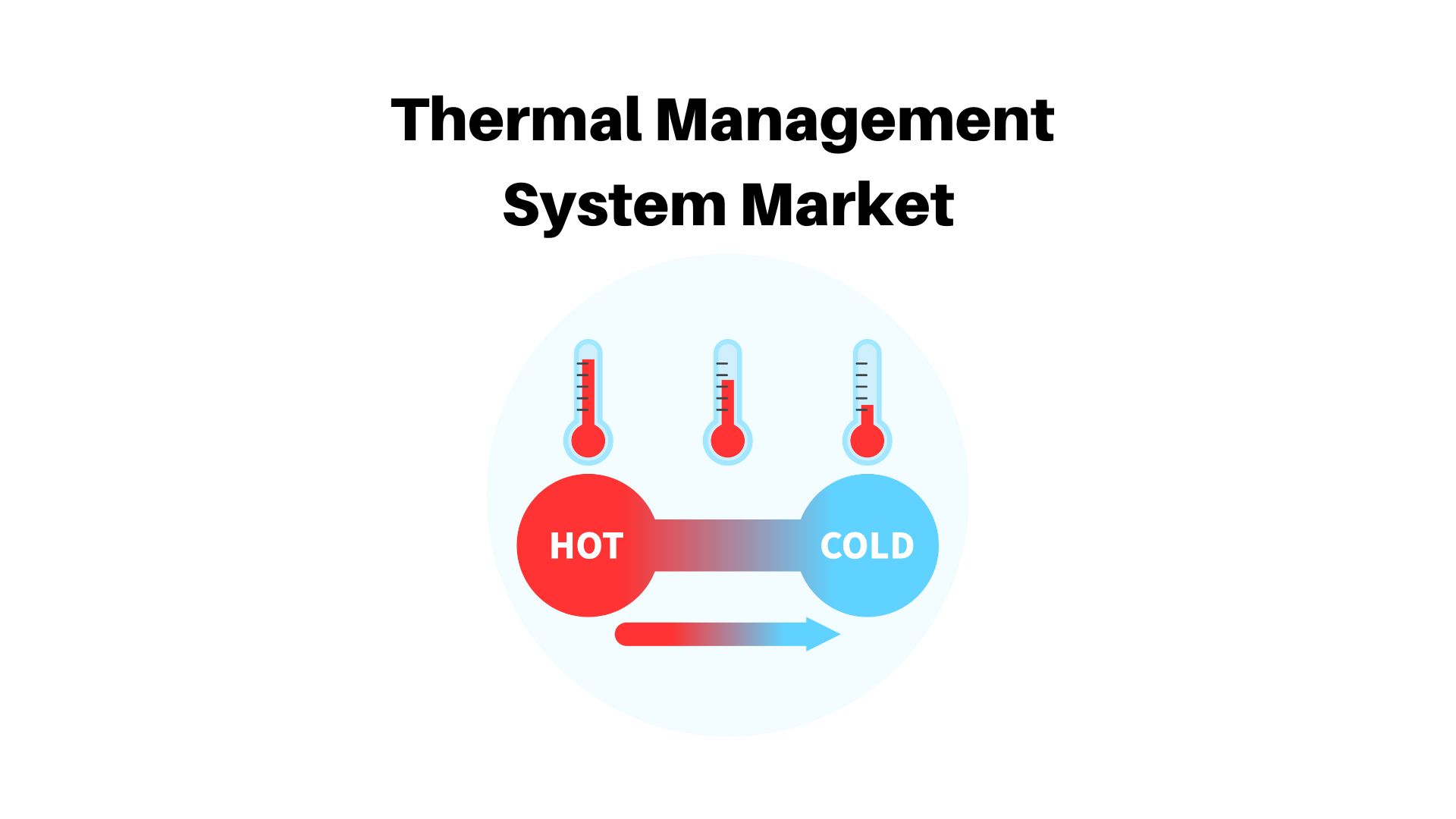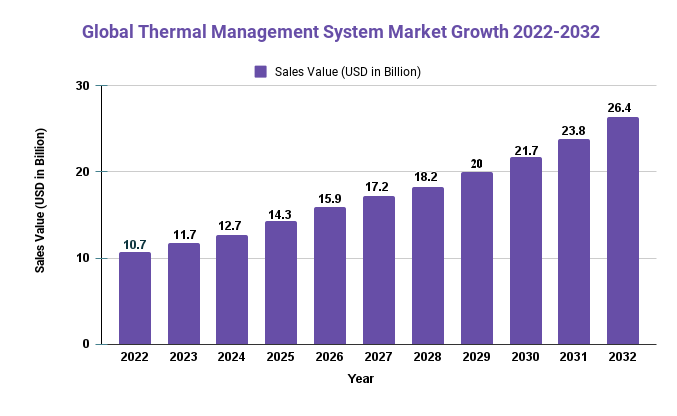Thermal Management System Market to Reach USD 26.4 Billion by 2032, Says Market.us Research Study

Page Contents
Market Overview
Published Via 11Press: The Thermal Management System Market size is expected to be worth around USD 26.4 Bn by 2032 from USD 10.7 Bn in 2022, growing at a CAGR of 9.7% during the forecast period from 2022 to 2032.
The thermal management system market is witnessing significant growth in recent years, driven by the increasing demand for effective cooling solutions across various industries. Thermal management systems are used to regulate and control the temperature of electronic devices and equipment, ensuring optimal performance and preventing damage due to excessive heat. The growing adoption of advanced electronics in automotive, aerospace, healthcare, telecommunications, and other sectors has fueled the demand for efficient thermal management systems.
One of the key factors driving the thermal management system market is the need to reduce energy consumption and improve efficiency. As electronic devices become more complex and powerful, they generate more heat which can lead to reduced performance or even failure if not managed effectively. Thermal management systems offer a cost-effective solution that helps maintain optimal operating temperatures while reducing energy usage. Increased awareness about environmental sustainability has also contributed to the growth of this market as companies seek eco-friendly alternatives that minimize their carbon footprint.
Want to Access the Statistical Data and Graphs, Key Player's Strategies | Request a sample report

Key Takeaways
- The global thermal management system market is anticipated to witness significant growth over the next few years, driven by factors such as rising demand for thermal management in various industries, rising adoption of electronic devices, and growing awareness regarding energy efficiency.
- The thermal management market is segmented based on type, component, application, and geography. Types of thermal management systems include active cooling systems, passive cooling systems, and hybrid cooling systems. Components used in these systems include hardware, software, and services.
- Thermal management systems find applications in data centers, automotive, aerospace, and defense, healthcare facilities, as well as consumer electronics.
- Asia-Pacific is expected to experience the fastest growth in the thermal management system market due to escalating electronic device demand and rising industrialization in this region.
- Major players in the thermal management system market include Emerson Electric, AMETEK, 3M, Parker Hannifin, Schneider Electric, Robert Bosch, LG, DANA, Continental, Valeo, and Calsonic Kansei. These firms are investing heavily in R&D to expand their product portfolios and maintain a competitive edge within the industry.
Regional Analysis
- North America is expected to dominate the thermal management system market due to the presence of major players there. Furthermore, this region has an accelerated adoption rate for advanced technologies, particularly in the automotive, aerospace & defense, and data center industries.
- Europe is expected to witness significant growth in the thermal management system market due to the rising adoption of renewable energy sources and demand for energy-efficient solutions. Furthermore, strict regulations regarding carbon emissions in this region fuel demand for thermal management solutions.
- Asia-Pacific is expected to be the fastest-growing region in the thermal management system market. It boasts a high demand for electronic devices and the increasing industrialization in this area are driving demand for thermal management solutions. Furthermore, there has been significant growth within the data center industry which also fuels demand for these systems.
- The Middle East and Africa region is expected to experience significant growth in the thermal management system market due to the increasing adoption of renewable energy sources and growing investment into oil & gas operations.
- The South American region is expected to experience significant growth in the thermal management system market due to the increasing adoption of advanced technologies in the automotive and healthcare industries. Furthermore, this region has a high adoption rate for renewable energy sources, further driving demand for thermal management solutions.
Drivers
- The growing need for thermal management solutions across various industries, Industries such as automotive, aerospace and defense, healthcare, and data centers have seen an uptick in demand for thermal management systems to maintain temperatures and enhance their operations. Rising Adoption of Electronic Devices, With the growing popularity of electronic devices such as smartphones, laptops, and tablets, thermal management systems are necessary to prevent overheating and guarantee the proper functioning of these gadgets.
- Awareness about Energy Efficiency As people become more educated on the need for energy efficiency, they demand thermal management solutions that can reduce both their energy usage and carbon emissions. Technological Advancements, The advancements in technologies such as the Internet of Things (IoT), Artificial Intelligence (AI), and Big Data analytics have allowed for the creation of cutting-edge thermal management systems with higher efficiency and superior performance.
- Government Regulations Governments around the world have implemented regulations to reduce carbon emissions, leading to the adoption of thermal management solutions that increase energy efficiency and minimize carbon footprint. Increased Demand for Electric and Hybrid Vehicles, With the growing interest in electric and hybrid vehicles, effective thermal management systems are necessary to protect their batteries at optimal performance levels.
- Overall, these drivers are expected to continue fueling the growth of the thermal management system market over the coming years.
Restraints
- High cost of thermal management systems: The high cost of thermal management systems can be a major restraint for small and medium-sized businesses that cannot afford to invest in expensive thermal management solutions.
- Design complexity: The design complexity of thermal management systems can be a significant challenge for manufacturers, which can increase the cost and time required for product development.
- Limited awareness and knowledge: Many end-users may not be fully aware of the benefits of thermal management systems or lack the technical knowledge to effectively operate and maintain these systems.
- Environmental concerns: The use of certain materials and technologies in thermal management systems can have negative environmental impacts, such as contributing to the generation of electronic waste or the emission of harmful gases.
- Supply chain disruptions: The COVID-19 pandemic has highlighted the risk of supply chain disruptions, which can impact the availability of critical components and materials used in thermal management systems.
- Competition from alternative solutions: There are alternative solutions to thermal management systems, such as natural cooling methods, which can be more cost-effective and environmentally friendly and may compete with the thermal management system market.
- Overall, these restraints may hinder the growth of the thermal management system market and require innovative solutions and strategies to overcome them.
Opportunities
- Integration with Cutting-Edge Technologies: Integrating thermal management systems with cutting-edge technologies like AI, IoT, and Big Data analytics can open up new avenues for innovation and differentiation in the market.
- Adoption of Renewable Energy Sources: With the growing use of renewable energy sources like solar and wind power, there are now opportunities for the development of energy-saving thermal management systems that reduce carbon emissions.
- Development of lightweight and compact thermal management systems: Recent advancements in lightweight and compact thermal management systems offer potential new applications in industries such as aerospace & defense and automotive.
- Expansion into Emerging Markets: For thermal management system manufacturers, expansion into emerging markets such as India and China could present new growth prospects due to the rising demand for electronic devices and industrialization in these regions.
- Collaboration with Other Industries: Collaboration between thermal management system manufacturers and other sectors such as renewable energy, electric vehicles, and smart homes can present new avenues for innovation and growth.
- Focus on Research & Development: Investment in research and development can lead to the creation of advanced thermal management technologies with higher efficiency, lower costs, and superior performance creating new market opportunities.
- Overall, these opportunities will enable the thermal management system market to continue its upward trajectory and offer new solutions that address energy efficiency, sustainability issues, and technology integration.
Challenges
- Rapidly evolving technology: The technology used in thermal management systems is rapidly evolving, making it challenging for manufacturers to keep up with new developments and develop products that are competitive in the market.
- High competition: The thermal management system market is highly competitive, with many players offering similar products and solutions. This can make it difficult for new entrants to gain a foothold in the market.
- Cost constraints: Cost is a critical factor for end-users when considering thermal management solutions. Manufacturers must balance the cost of their products against the performance and efficiency benefits they offer.
- The complexity of system design: Thermal management systems can be complex, requiring specialized knowledge and skills to design and manufacture. This can make it challenging for manufacturers to develop products that meet the needs of their customers.
- Environmental concerns: End-users, and governments are becoming increasingly concerned about the environmental impact of electronic devices and associated technologies, including thermal management systems. This can create challenges for manufacturers looking to develop products that meet the needs of their customers while minimizing environmental impacts.
- Supply chain disruptions: The COVID-19 pandemic has highlighted the risk of supply chain disruptions, which can impact the availability of critical components and materials used in thermal management systems. Manufacturers need to develop strategies to manage supply chain risks and ensure continuity of supply.
- Overall, these challenges require manufacturers in the thermal management system market to be innovative, responsive to customer needs, and adaptable to changing market conditions.
Browse the summary of the report and Complete the Table of Contents (TOC)
Recent Development
- Henkel bought Thermexit, the thermal management material business segment of Nanoramic Laboratories in September 2022. Henkel has strengthened its position within the growing market for thermal interface material (TIM).
- Nextreme Recirculating Chiller was launched in May 2022. This platform features high-quality components, environmentally-friendly refrigerants, low-noise components, and an easy-to-use operator interface. The new chiller uses variable-speed motors with high performance for noise reduction, reduced room heat input, and lower energy consumption.
- Limco Airepair (a wholly owned subsidiary TAT) signed a contract extension with Collins Aerospace in October 2022 to provide maintenance repair and overhaul (MRO), for Boeing 777 thermal components. TAT customers will now have access to Collins's services through this contract.
Report Scope
| Report Attribute | Details |
| The market size value in 2022 | USD 10.7 Bn |
| Revenue forecast by 2032 | USD 26.4 Bn |
| Growth Rate | CAGR Of 9.7% |
| Regions Covered | North America, Europe, Asia Pacific, Latin America, and Middle East & Africa, and the Rest of the World |
| Historical Years | 2017-2022 |
| Base Year | 2022 |
| Estimated Year | 2023 |
| Short-Term Projection Year | 2028 |
| Long-Term Projected Year | 2032 |
Key Market Segments
Type
- Passive
- Active
Application
- Consumer Electronics
- Automotive
- Medical Electronics
- Aerospace and Defense
- Other
Key Market Players included in the report:
- Emerson Electric
- AMETEK
- 3M
- Parker Hannifin
- Schneider Electric
- Robert Bosch
- LG
- DANA
- Continental
- Valeo
- Calsonic Kansei
Frequently Asked Questions
What is the market study period?
The Thermal Management System Market is studied from 2017 – 2032.
What is the growth rate for the Thermal Management System Market?
The Thermal Management System Market is growing at a CAGR of 9.7%
Who are the major players in the Thermal Management System Market?
Emerson Electric, AMETEK, 3M, Parker Hannifin, Schneider Electric, Robert Bosch, LG, DANA, Continental, Valeo, Calsonic Kansei
The team behind market.us, marketresearch.biz, market.biz and more. Our purpose is to keep our customers ahead of the game with regard to the markets. They may fluctuate up or down, but we will help you to stay ahead of the curve in these market fluctuations. Our consistent growth and ability to deliver in-depth analyses and market insight has engaged genuine market players. They have faith in us to offer the data and information they require to make balanced and decisive marketing decisions.



